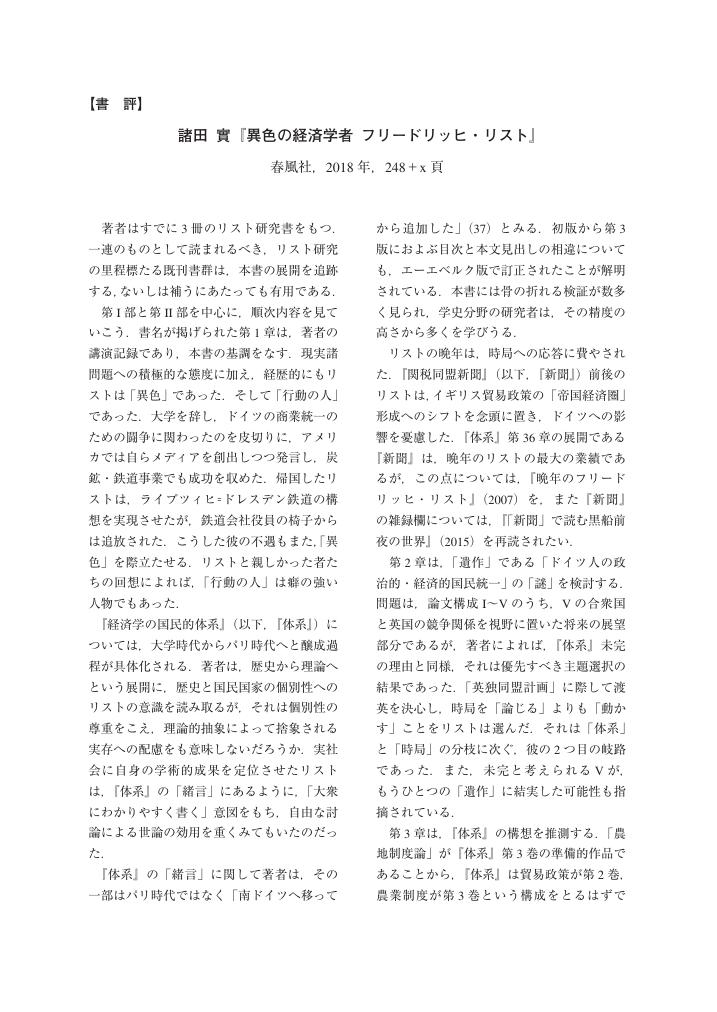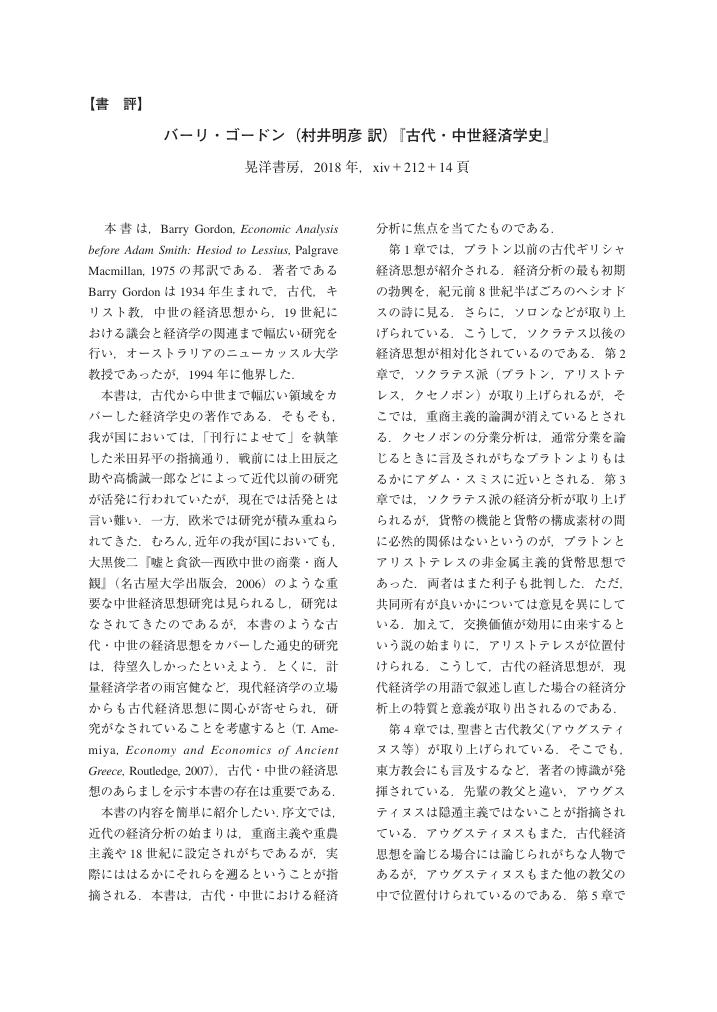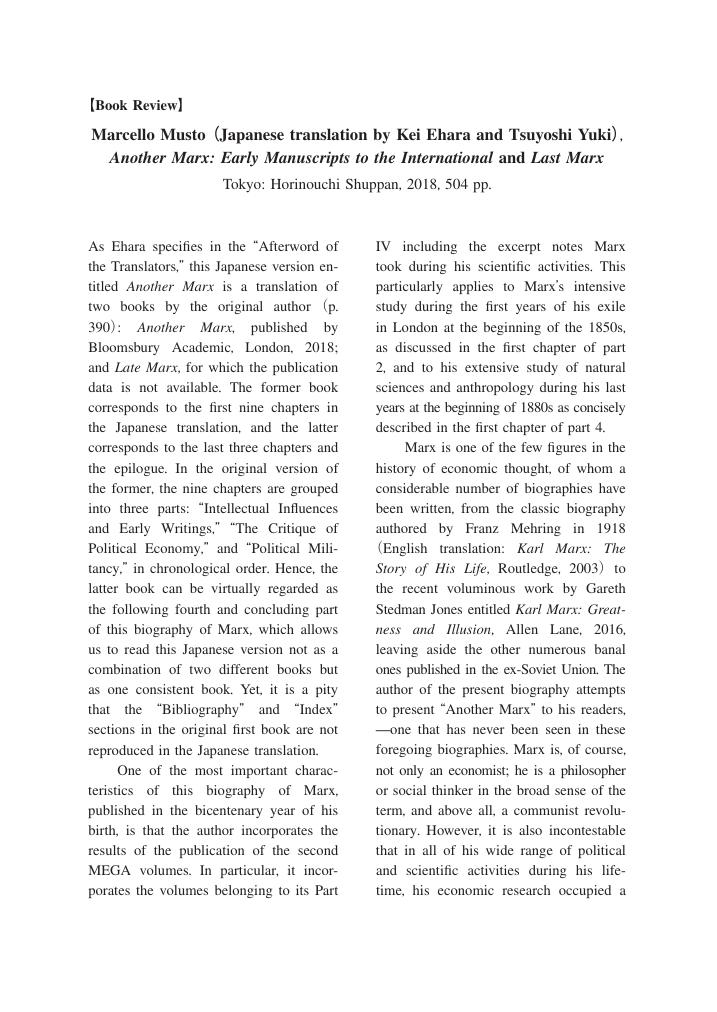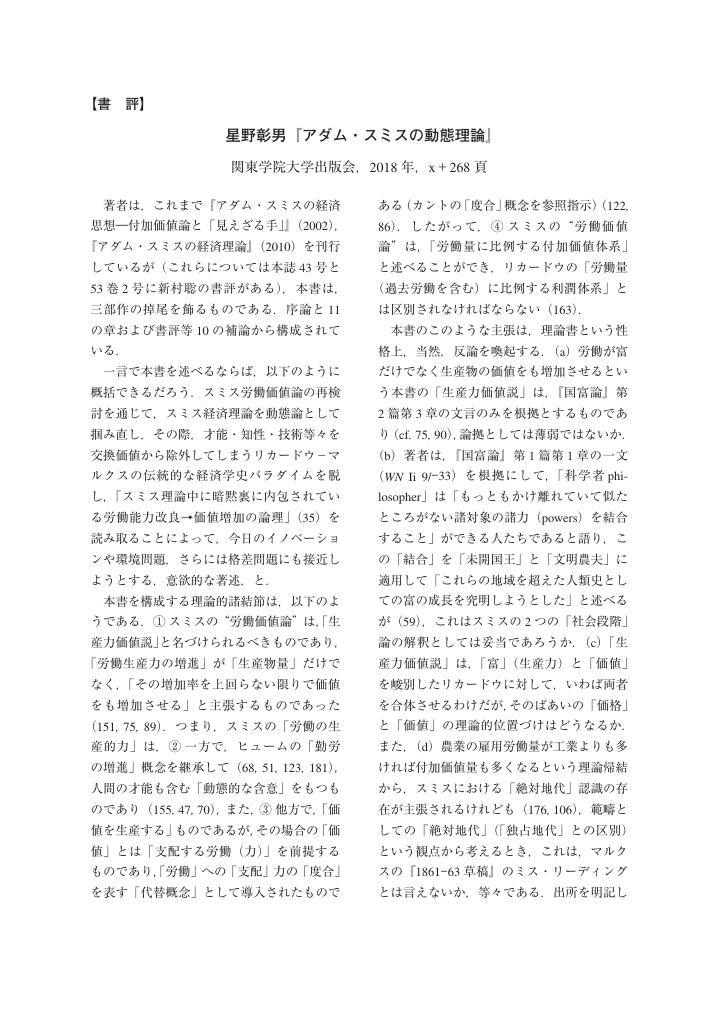- 著者
- 吉井 哲
- 出版者
- 経済社会学会
- 雑誌
- 経済社会学会年報 (ISSN:09183116)
- 巻号頁・発行日
- vol.37, pp.104-114, 2015 (Released:2016-03-25)
Ricardo (1817) classifies goods into scarce goods and produced goods, and thinks that the laws of supply and demand regulate the price of scarce goods and that the labor embodied value theory regulates the price of produced goods. He puts importance on a production cost principle because produced goods are more important economically. However, Ricardo in Notes on Malthus’s principles of Political Economy (1820) approves Malthus’s assertion that the laws of supply and demand are the principle governing whole pricing even if it is the natural price. How should we consider this fact? The natural price is regulated by the production cost at the level of supply that is equal to the quantity of effective demand. Ricardo postulates a diminishing return in an agricultural sector, and an increasing return in an industrial sector. Therefore, a producer cannot determine a production cost per unit until the quantity of production is not determined. So, a producer has to grasp the effective demand in a market. That is to say, there is a strong relationship between an effective demand and the quantity of supply before the determination of a production cost. For Ricardo, "the laws of supply and demand" are not an opponent concept to a production cost principle, but rather a necessary concept for a production cost principle to have validity to the reality. Such a classical pricing method is similar to a market base pricing (target costing) that a present-day manufacturing adopts.
1 0 0 0 OA 行動経済社会学研究の構想
- 著者
- 岩澤 誠一郎
- 出版者
- 経済社会学会
- 雑誌
- 経済社会学会年報 (ISSN:09183116)
- 巻号頁・発行日
- vol.37, pp.62-75, 2015 (Released:2016-03-25)
Traditional neoclassical economics analyzes economic outcomes assuming that agents rationally maximize their self-interests. On the other hand, economic sociology emphasizes that superstructure such as religious beliefs, or social structure such as weak ties, could well affect economic outcomes via agents’ preferences and choice sets, and warns against the negligence of social factors in traditional economics. This paper proposes a new line of economic sociology research that incorporates recent developments of cognitive psychology and neuroscience. Following Kahneman (2003, 2011), the paper distinguishes two modes of thinking and deciding: “System 1” and “System 2,” which roughly correspond to “emotion and intuition” and “reasoning.” While traditional neoclassical economics theorizes economic transactions assuming only System 2 and ignoring System 1, behavioral economics emphasizes that actual economic decisions are substantially influenced by System 1. Current mainstream behavioral economic research, however, rarely goes beyond this, and suggests that only System 2, as opposed to System 1, should be fully utilized in a rational economic decision making. This is at odds with the recent findings of neuroscience that social cognition, which mainly consists of System 1, is the basis of many socially desirable empirical facts including the one that quantity of public goods’ supply is much greater than what is predicted by traditional economic theory. The paper proposes a new sub-field of economic sociology, which can be called “behavioral economic sociology” that analyzes social factors influencing economic outcomes by way of System 1. The paper develops this idea by examining recent organizational psychology researches called “positive organizational scholarship.”
- 著者
- 佐々木 満実
- 出版者
- 公益財団法人 史学会
- 雑誌
- 史学雑誌 (ISSN:00182478)
- 巻号頁・発行日
- vol.124, no.10, pp.1825-1826, 2015-10-20 (Released:2017-07-31)
1 0 0 0 OA トリプトファン代謝と疾患 生体防御と破壊
- 著者
- 斉藤 邦明 藤垣 朱和子 清島 満
- 出版者
- 一般社団法人 日本臨床化学会
- 雑誌
- 臨床化学 (ISSN:03705633)
- 巻号頁・発行日
- vol.29, no.3, pp.103-112, 2000-09-30 (Released:2012-11-27)
- 参考文献数
- 33
1 0 0 0 朝日文左衛門『鸚鵡籠中記』
- 著者
- 朝日文左衛門[原著] 加賀樹芝朗著 出版工房ケンブリッジ編
- 出版者
- 雄山閣
- 巻号頁・発行日
- 2003
- 著者
- 青木 孝志
- 出版者
- International Society of Life Information Science
- 雑誌
- 国際生命情報科学会誌 (ISSN:13419226)
- 巻号頁・発行日
- vol.21, no.2, pp.416-427, 2003-09-01 (Released:2019-05-03)
- 参考文献数
- 37
伝統的東洋医学のなかに手技による外気功がある。これを機械化する挑戦-手技以上の能力をもち信頼性のある科学的・機械化装置を開発するという挑戦-が望ましい。この挑戦は、一方で、気とは何か、発気のメカニズムは何かという伝統的東洋医学の気の思想における命題を解く試みにも通ずるところがある。筆者は、気が発生するメカニズムとして生体の電磁気学的現象に基づいた仮説をたて、仮説に基づいた数種類の装置を製作し、装置から発生する干渉波を含む複合電磁波が惹起する治療効果等々の生理的作用効果を計測し検討した。これらの装置は、各装置の電磁波成分の種類・強度・成分比・周波数などの違いにより、それぞれ作用効果に特微か現れるが、総じて、これらの装置は、すべて治療効果を含む生理的変化を惹起した。また、一部の装置では、照射により非生命体のNMR、水の粘性係数、光学吸収に変化が起こることを確認した。非生命体に対するこのような効果と生体に対する治療効果を含む生理的作用効果は、気功外気によるものと類似性が認められた。従って、このような複合電磁波が気功外気に類似のものであることを示唆した。
1 0 0 0 プラズマ波動のダイナミックスと乱れ
1.ビ-ム・プラズマ系での不安定波の成長過程におけるソリトンの役割が明らかにされた。ソリトン生成による不安定モ-ドの安定化が示され、実験によって確かめられた。2.大振幅磁気音波による共鳴加速という新しい粒子加速機構が提唱され、太陽フレア-における短時間内での粒子加速の説明に成功した。3.ダブルプラズマ発生装置を用いて、ポンプ波の周期倍化現象や電子プラズマ波の高調波励起等のカオス的振舞いを観測した。4.散逸項を含む「非線形シュレディンガ-方程式」を例にとり、ソリトン振動論を用いて、多ソリトン状態の性質を明らかにした。5.磁力線に沿って伝播する非線形アルフベン波を「微分型非線形シュレディンガ-方程式」を用いて研究し、その初期値と生ずるソリトンの個数との関係を明らかにした。6.渦糸近似により、ドリフト波の動的、統計的性質を調べた。特に、渦糸の拡散係数を解析的に求めることに成功した。7.不均一密度の磁化プラズマ中におけるドリフト波の伝播特性や自然励起波の性質が調べられた。磁場に対して右ねじ方向のEXBドリフトのシアを与え、小電極励起子に正のパルスを与えたところ、ソリトン的性質を持つ正電位のドリフト波パルスが伝播することが観測された。8.イオン波ソリトンの反射及び透過現象を観測し、その解析を行なった。また、大振幅イオン波の励起手法の開発が行なわれた。9.結び目理論において、より強力な新しい絡み目多項式がソリトン理論から構成できることを示した。このような多種多様な分野において、新しい非線形現象が見出された。研究計画には理論家、実験家がほぼ同数含まれ、互いの研究発展を促進できたことは非常にうれしく思っている。
- 著者
- Namrath Chatchaiyan Kaoru Koide Makoto Tsuchimochi Hajime Tanji Eiichiro Asano Hironobu Ishii Toshihide Sato Mami Ishii Atsuko Kondo Keishi Ohta
- 出版者
- Japan Prosthodontic Society
- 雑誌
- Prosthodontic Research & Practice (ISSN:13477021)
- 巻号頁・発行日
- vol.7, no.2, pp.222-224, 2008 (Released:2008-11-05)
- 参考文献数
- 5
The purpose of this study was to achieve optimal contrast of imaging characteristics in 4 dimensional MR images of the temporomandibular joint (TMJ) for evaluating the TMJ structures during mandibular movement. Twelve TMJs from six subjects without any TMJ dysfunction were studied. MRI was performed using a 1.5 MR system with an eight-channel phased array coil. The images were acquired using a balanced steady-state free precession (b-SSFP) sequence. The optimal flip angle was determined for differentiation for the main anatomical structures of the TMJ; the posterior band of the articular disc, the retrodiscal tissues, the condylar head, and the lateral pterygoid muscle, by examining the signal intensity (SI-d) of TMJ structures on b-SSFP MR images obtained using various flip angles. Repeated measures two-way analysis of variance (ANOVA) was performed, followed by Bonferroni's multiple comparison analysis. The main anatomical structures of the TMJ had the highest SI-d at flip angles of 30 degrees and 40 degrees, and there were the most significant differences between the SI-d of the articular disc and all other structures at a flip angle of 40 degrees, followed by a flip angle of 30 degrees. These data suggest that a flip angle of approximately 30 degrees to 40 degrees is appropriate for obtaining the optimal contrast of imaging characteristics for 4 Dimensional MR images of the TMJ with b-SSFP sequence.
- 著者
- 松永 友有
- 出版者
- 経済学史学会
- 雑誌
- 経済学史研究 (ISSN:18803164)
- 巻号頁・発行日
- vol.62, no.1, pp.26-50, 2020 (Released:2020-10-16)
John Maynard Keynes is known to have frequently changed his opinion on free trade and protection. There have been two contrasting interpretations of Keynes’s thought on the external economic policy, with one considering him essentially a free trader and the other finding him a protectionist. This article elucidates an original coherent explanation for Keynes’s ambiguous thinking on Britain’s external economic policy by observing the contradictory coexistence of economic nationalism and pacifist free-trade ideology among the New Liberals (left-leaning Liberals), of whom he was one. Since the 19th century, Britain had a peculiar political tradition in that the proposal of a protectionist policy almost entirely came from the political right, whereas the political left monolithically supported unconditional free trade under the influence of Richard Cobden’s idealistic internationalism. New Liberals, such as J.A. Hobson and Keynes, were sympathetic to the vision of a balanced national economy in which the manufacturing, rather than the financial sector, played a central role. In this sense, New Liberals had much in common with the historical economists, such as William Cunningham and William Ashley, who supported the Conservative Party’s protectionist campaign. Both Hobson’s theory of underconsumption and Keynes’s theory of effective demand emphasized the importance of domestic, rather than foreign markets. This meant that the New Liberals’ economic thinking was essentially more congruent with a protectionist policy to safeguard domestic manufacturing industries than free trade. Nevertheless, the New Liberals found it extremely difficult to support a protectionist policy because of protectionism’s strong association with right-wing politics in Britain and its incommensurability with their belief in a pacifist free-trade ideology. This dilemma formed the backdrop of Keynes’s allegedly inconsistent attitudes on the external economic policy of his time. JEL classification numbers: B10, B20, B27.
1 0 0 0 OA 玉野井芳郎「エコノミーとエコロジー」
- 著者
- 八木 紀一郎 チャペスキー ロバート 玉野井 芳郎
- 出版者
- The Japanease Society for the History of Economic Thought
- 雑誌
- 経済学史研究 (ISSN:18803164)
- 巻号頁・発行日
- vol.62, no.1, pp.51-75, 2020 (Released:2020-10-16)
- 被引用文献数
- 1
1 0 0 0 OA 諸田實『異色の経済学者 フリードリッヒ・リスト』春風社,2018年,248+x 頁
- 著者
- 大塚 雄太
- 出版者
- 経済学史学会
- 雑誌
- 経済学史研究 (ISSN:18803164)
- 巻号頁・発行日
- vol.61, no.2, pp.94-95, 2020 (Released:2020-02-29)
- 著者
- 堂目 卓生
- 出版者
- 経済学史学会
- 雑誌
- 経済学史研究 (ISSN:18803164)
- 巻号頁・発行日
- vol.61, no.2, pp.98-99, 2020 (Released:2020-02-29)
- 著者
- 星野 彰男
- 出版者
- 経済学史学会
- 雑誌
- 経済学史研究 (ISSN:18803164)
- 巻号頁・発行日
- vol.61, no.2, pp.82-83, 2020 (Released:2020-02-29)
- 著者
- 大槻 忠史
- 出版者
- 経済学史学会
- 雑誌
- 経済学史研究 (ISSN:18803164)
- 巻号頁・発行日
- vol.61, no.2, pp.96-97, 2020 (Released:2020-02-29)
- 著者
- 泉 正樹
- 出版者
- 経済学史学会
- 雑誌
- 経済学史研究 (ISSN:18803164)
- 巻号頁・発行日
- vol.61, no.2, pp.86-87, 2020 (Released:2020-02-29)
- 著者
- 野原 慎司
- 出版者
- 経済学史学会
- 雑誌
- 経済学史研究 (ISSN:18803164)
- 巻号頁・発行日
- vol.61, no.2, pp.88-89, 2020 (Released:2020-02-29)
- 著者
- 仲北浦 淳基
- 出版者
- 経済学史学会
- 雑誌
- 経済学史研究 (ISSN:18803164)
- 巻号頁・発行日
- vol.61, no.2, pp.90-91, 2020 (Released:2020-02-29)
- 著者
- 竹永 進
- 出版者
- 経済学史学会
- 雑誌
- 経済学史研究 (ISSN:18803164)
- 巻号頁・発行日
- vol.61, no.2, pp.92-93, 2020 (Released:2020-02-29)
- 被引用文献数
- 1
1 0 0 0 OA 星野彰男『アダム・スミスの動態理論』関東学院大学出版会,2018 年,x+268 頁
- 著者
- 佐藤 滋正
- 出版者
- 経済学史学会
- 雑誌
- 経済学史研究 (ISSN:18803164)
- 巻号頁・発行日
- vol.61, no.1, pp.139-140, 2019 (Released:2019-10-14)
- 著者
- 浅田 統一郎
- 出版者
- The Japanease Society for the History of Economic Thought
- 雑誌
- 経済学史研究 (ISSN:18803164)
- 巻号頁・発行日
- vol.61, no.1, pp.135-136, 2019 (Released:2019-10-14)













